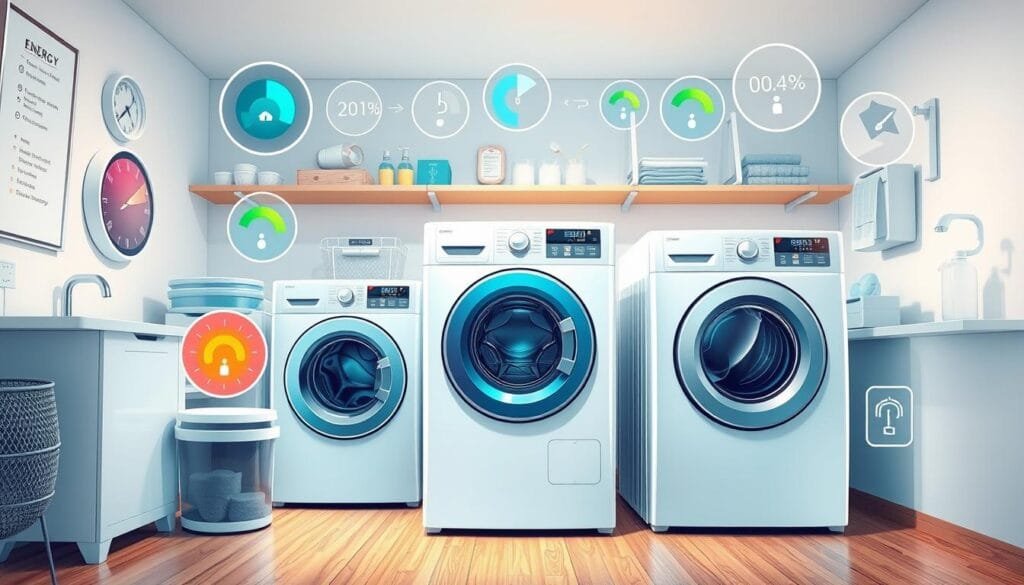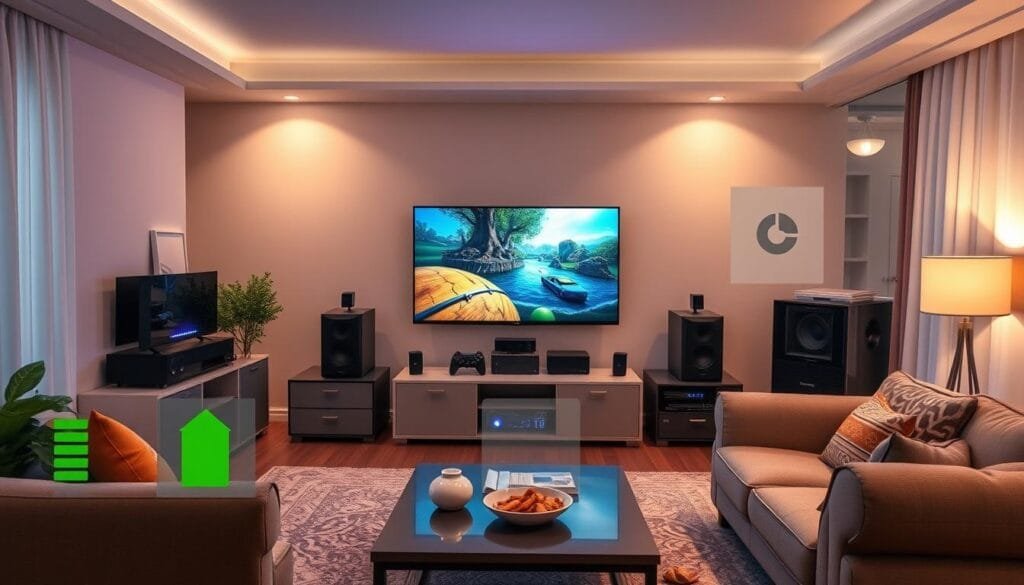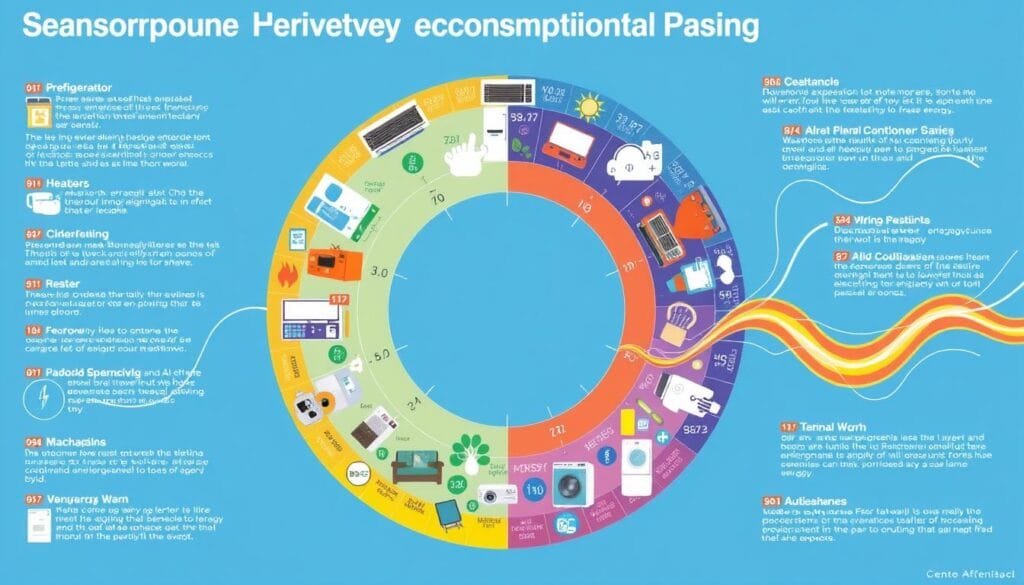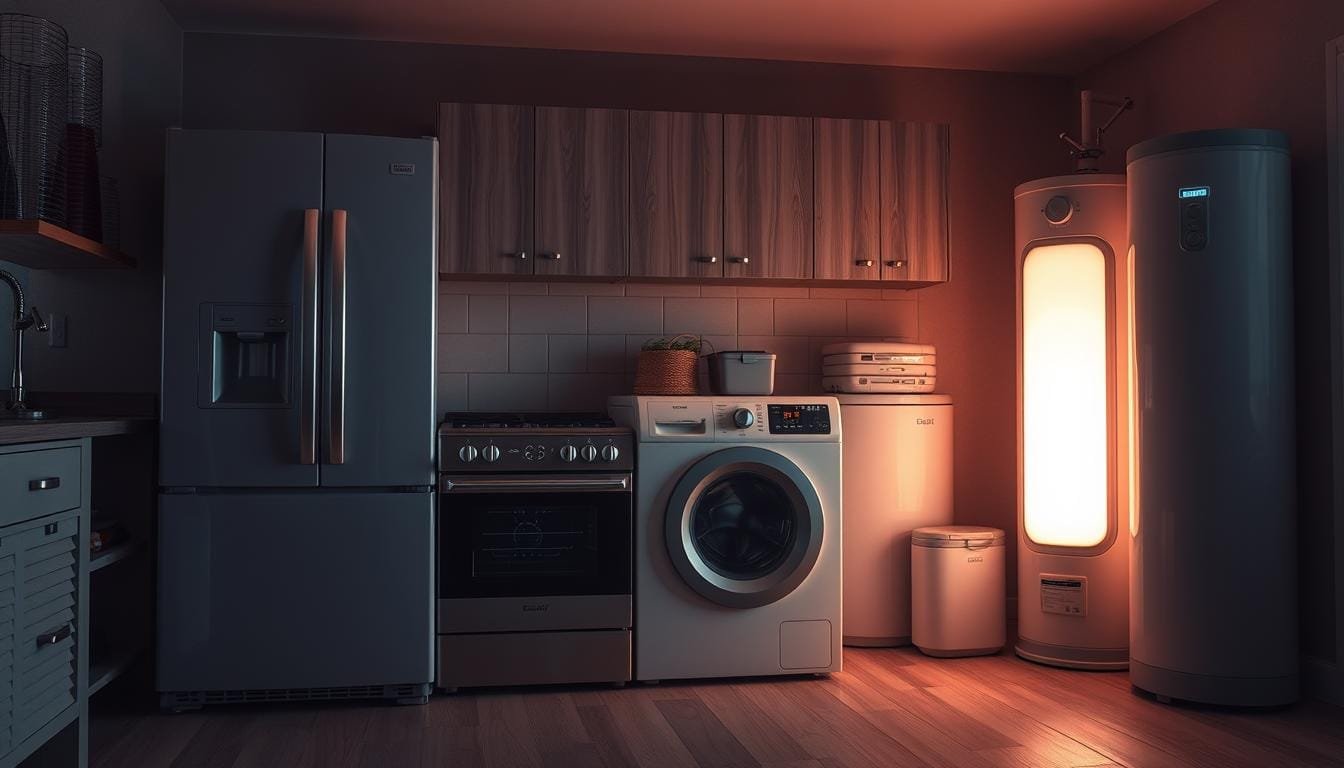Did you know the average U.S. household spends about $115 a month on electricity? Almost 35% of this is wasted by energy-hungry appliances. Knowing which appliances use the most electricity can help you save money and cut down on your bills.
Modern homes are full of devices that quietly use power, even when they seem off. These appliances can greatly increase your energy use, leading to hidden costs that many people don’t notice.
Every device in your home, from heaters to kitchen tools, adds to your electricity bill. By finding out which devices use the most power, you can improve your home’s energy efficiency. This could save you hundreds of dollars every year.
Key Takeaways
- Approximately 35% of household electricity is wasted through inefficient appliance usage
- Understanding energy consumption can lead to significant cost savings
- Some appliances consume power even when seemingly turned off
- Strategic management of electrical devices can reduce monthly utility bills
- Energy-efficient alternatives exist for most high-consumption appliances
Understanding Home Electricity Consumption Patterns
Electricity use in American homes changes a lot depending on where you live and your household. Looking at power-guzzling devices gives us interesting insights into how we use energy at home.
The U.S. Energy Information Administration shares important data on household electricity use. On average, American homes use about 10,500 kilowatt-hours (kWh) of electricity each year. But, there are big differences in usage across different areas.
Regional Electricity Consumption Breakdown
| Region | Average Annual Consumption |
|---|---|
| Northeast | 7,000 kWh |
| Midwest | 10,000 kWh |
| South | 14,000 kWh |
| West | 8,000 kWh |
Factors Affecting Residential Power Usage
Several key factors influence high-electricity consumption in homes:
- Home size and layout
- Number of occupants
- Climate and seasonal variations
- Efficiency of electrical appliances
- Personal energy consumption habits
Peak vs. Off-Peak Usage Times
Knowing when you use the most electricity can help you use less. Peak usage happens in the morning and evening when everyone is home and using more devices.
“Awareness of energy consumption patterns can lead to significant cost savings and more efficient electricity use.” – Energy Efficiency Expert
Time-of-use electricity rates can help you save money. By moving your high-energy activities to off-peak hours, you can cut down on your energy costs.
HVAC Systems: The Biggest Power Consumer
Heating, Ventilation, and Air Conditioning (HVAC) systems are the biggest energy users in homes. They use 46% of the average U.S. home’s energy. This makes them the biggest power users in most homes.
“Your HVAC system is the heart of your home’s energy ecosystem, pumping power through every room.”
HVAC systems use a lot of energy, depending on where you live and the season. Space cooling uses 16.6% of household electricity, while space heating uses 12.89%. These numbers show how important HVAC systems are for managing home energy.
Key HVAC Energy Consumption Insights
- Heating and cooling systems use 52% of total home energy
- Central air conditioners use a lot of energy in summer
- Heating systems use a lot of electricity in winter
Homeowners can lower HVAC energy use in several ways:
- Install programmable thermostats
- Do regular system maintenance
- Improve home insulation
- Choose energy-efficient HVAC models
| HVAC Component | Electricity Consumption |
|---|---|
| Space Cooling | 16.6% |
| Space Heating | 12.89% |
| Total HVAC Impact | 52% |
Investing in energy-efficient HVAC technologies can lower electricity costs. Homeowners may also get tax credits up to $2,000.
Water Heaters: Second Largest Energy Draw
Water heaters are big users of electricity in homes. They use a lot of energy, making up about 18% of a home’s utility bill. Knowing how much energy they use can help homeowners choose better water heating systems.
Electric vs. Gas Water Heater Consumption
Choosing between electric and gas water heaters affects energy use. Electric water heaters use 4,000 to 5,500 kWh each year. Gas models use 20-50 therms of gas monthly, which might be cheaper.
- Electric water heaters average 5,000 watts of electricity
- Estimated cost: $180 per year at standard electricity rates
- Gas water heaters cost approximately $12-$18 per month to operate
Impact of Daily Hot Water Usage
How much hot water you use every day affects your energy bill. An average family uses about 64 gallons of hot water daily for things like:
- Clothes Washer: 25 gallons per use
- Shower: 10 gallons per use
- Dishwasher: 6 gallons per use
- Kitchen and Bathroom Faucets: 2 gallons per minute
Energy-Saving Temperature Settings
Controlling the temperature of your water heater can save energy. Lowering the temperature from 140 to 120 degrees can save up to $54 annually. Other ways to save include:
- Insulating water heater tanks
- Using low-flow fixtures
- Considering energy-efficient models like heat pump water heaters
Energy Star estimates a Heat Pump Water Heater will cost about $265 per year to operate, potentially saving a lot in the long run.
Appliances That Use The Most Electricity in Modern Homes
Modern homes have many appliances that use a lot of electricity. Knowing which ones use the most can help you save energy and money.
Each appliance uses different amounts of electricity. Some use a lot more than others, affecting your energy bill.
- Refrigerators consume approximately 6.9% of residential electricity
- Consumer electronics drain nearly 6% of home energy
- Lighting accounts for 4.4% of electricity usage
Knowing which appliances use a lot of energy can help you save. Energy-efficient alternatives and smart technologies are key to managing your home’s energy use.
| Appliance | Monthly Energy Consumption (kWh) | Estimated Annual Cost |
|---|---|---|
| Refrigerator | 200-400 | $50-$100 |
| Television | 100-300 | $25-$75 |
| Computer | 50-250 | $15-$60 |
“Understanding your home’s energy consumption is the first step toward reducing electricity costs.” – Energy Efficiency Expert
Using ENERGY STAR ratings and smart home tech can help you manage your energy use better. Making smart choices can lower your electricity bills a lot.
Refrigeration Units: Always-On Energy Users
Refrigerators are among the biggest energy users in our homes. They run all the time to keep our food fresh and cool. On average, a fridge uses about 162 kWh each month. This makes it a big part of our energy use at home.
Energy Consumption Patterns
Knowing how much energy fridges use helps us make better choices. Several things affect how much energy a fridge uses:
- How old the fridge is
- Its size and how much it can hold
- How cold we set it
- How often we open the door
- Where it’s located and the temperature around it
“One in four Americans owns a second refrigerator, which can add an extra $125 to annual electricity bills.”
Efficiency Ratings and Performance
When looking for energy-using appliances, check the Energy Star ratings. These ratings show which fridges are the most energy-efficient.
Important things to look at include:
- How much energy it uses each year
- How well it’s insulated
- How efficient the compressor is
- How steady the temperature stays
Pro tip: Keeping your fridge in good shape can cut down on energy use and make it last longer.
Laundry Equipment Power Usage

Laundry equipment is a big user of electricity in homes today. Washing machines and dryers use a lot of power, making up about 5% of a home’s energy use.
Knowing how much energy laundry equipment uses helps homeowners save on electricity. A typical washing machine uses between 400 to 1,400 watts. This can affect your monthly electricity bill a lot.
“Smart laundry practices can significantly reduce your home’s energy footprint.”
Energy Consumption Breakdown
- Weekly electricity usage (900W washer, 3x/week): 2.7 kWh
- Monthly electricity usage: 11.7 kWh
- Yearly electricity usage: 140.4 kWh
Cost Considerations by State
| State | Monthly Cost | Yearly Cost |
|---|---|---|
| California | $2.57 | $30.89 |
| New York | $2.41 | $28.91 |
| U.S. Average | $1.66 | $19.92 |
To cut down on electricity use, look for energy-efficient washing machines. Use cold water and wash full loads to save energy.
Energy-Saving Tips
- Choose front-loading washers
- Wash clothes in cold water
- Air dry when possible
- Maintain your appliances regularly
By following these tips, you can lower your laundry’s energy use. This will also help you save money on your electricity bills.
Kitchen Appliances and Their Energy Impact
Modern kitchens have many energy-using appliances. These appliances use a lot of electricity. Knowing how much power they need helps homeowners save energy.
Cooking Appliances Energy Consumption
Cooking appliances use a lot of electricity. An oven at 2,500 watts for an hour a day uses about 75 kWh a month. A stovetop at medium-high heat uses around 45 kWh a month.
- Ovens: High energy consumption at 2,500 watts
- Stovetops: Moderate energy use at 1,500 watts
- Microwaves: More energy-efficient alternative for small meals
Dishwasher Power Requirements
Dishwashers use a lot of energy in kitchens. They account for about 14% of a household’s energy bill. This includes washing machines, dishwashers, and tumble dryers.
“Choosing an energy-efficient dishwasher can lead to substantial electricity savings over time.”
| Dishwasher Rating | Annual Running Cost (GB) | Annual Running Cost (NI) |
|---|---|---|
| A-rated 12-place | £35 | £45 |
| G-rated equivalent | £70 | £85 |
To use less energy, run full loads, use eco-settings, and pick high-efficiency appliances.
Understanding Phantom Load and Standby Power
Phantom load, or standby power, is a hidden way homes use electricity. Even when devices seem off, they keep using power. Amazingly, 75% of the power used by plugged-in devices is when they’re not on.
Many big appliances quietly use power, adding to our bills. The Department of Energy says home electronics use 75% of their power when off. This can really hurt our wallets.
“Phantom loads can cost the average household over $150 annually in wasted electricity.”
Common Phantom Load Culprits
- Television sets
- Computer monitors
- Cable boxes
- Game consoles
- Phone chargers
Phantom Load Cost Breakdown
| Device | Annual Watts | Estimated Cost |
|---|---|---|
| Cable TV Receiver | 12.5 | $22.67 |
| Desktop Computer | 7.5 | $4.53 |
| Computer Monitor | 6.9 | $4.17 |
Reducing Phantom Power Consumption
- Use smart power strips
- Unplug devices when not in use
- Choose ENERGY STAR-certified electronics
- Utilize power management settings
By tackling phantom loads, we can cut down on electricity use. This means lower bills every month.
Home Entertainment Systems Energy Usage

Modern home entertainment systems use a lot of electricity. They can really raise your monthly power bill. Even though they’ve become more energy-efficient, they’re among the biggest power users in homes.
Devices like TVs, gaming consoles, and streaming gear use about 2.7% of all home energy. This small percentage can add up to big electricity costs over time.
“Smart management of home entertainment systems can lead to meaningful energy savings,” says energy efficiency expert Michael Roberts.
Energy Consumption Breakdown
- Televisions: Average 80-400 watts during use
- Gaming Consoles: 50-150 watts when active
- Cable/Satellite Boxes: 20-50 watts in standby mode
- Streaming Devices: 2-5 watts during operation
| Device | Active Power (Watts) | Standby Power (Watts) |
|---|---|---|
| LED Television | 100-200 | 0.5-2 |
| LCD Television | 150-250 | 1-3 |
| Gaming Console | 90-150 | 10-20 |
To cut down energy use, try using smart power strips. Also, adjust brightness settings and unplug devices when not in use. These easy steps can help lower electricity bills from home entertainment systems.
Lighting Systems and Their Power Requirements
Lighting is a big part of home energy use, making up about 9% of all electricity. Knowing how much power different lights use helps homeowners choose wisely. This can lead to using less energy.
Today, homes have many ways to control lighting energy use. New lighting tech offers better ways to cut down on electricity use.
LED vs Traditional Bulb Consumption
The energy use between old and new bulbs is huge:
- Incandescent 100W bulb: Uses 0.2 kWh daily
- Energy-efficient LED bulb: Consumes only 7-10W
- Monthly lighting energy consumption can reach up to 300 kWh
Choosing LED bulbs can cut down on electricity bills a lot. An energy-efficient LED light bulb uses much less power than old bulbs.
Smart Lighting Solutions
Smart lighting brings new ways to save energy:
- Motion sensors that automatically turn lights off
- Dimming capabilities to reduce power consumption
- Scheduling systems to optimize lighting usage
“Smart lighting isn’t just about convenience—it’s about intelligent energy management.”
| Lighting Type | Power Consumption | Monthly Cost Estimate |
|---|---|---|
| Incandescent Bulb | 100W | $15-$20 |
| LED Bulb | 7-10W | $2-$5 |
Using these smart lighting tips can greatly lower electricity use. This helps make energy use more sustainable.
Smart Home Technology for Energy Management
Smart home tech is changing how we handle energy use at home. These systems give us control over devices that use a lot of power. They help us use less energy and save on our bills.
Smart home energy management systems have many benefits:
- Real-time energy consumption tracking
- Automatic device power management
- Remote control of home appliances
- Integration with renewable energy sources
Some key techs making homes more energy-efficient include:
- Smart Thermostats: Cut heating and cooling costs by up to 15%
- Smart Plugs: Stop standby power waste
- Energy Monitoring Systems: Give detailed usage insights
“Smart home technologies can help households use 30-40% less energy compared to conventional home setups.” – ENERGY STAR Research
Features like geofencing and scheduled controls make energy management smarter. Samsung’s SmartThings Energy is the first ENERGY STAR certified system. It shows how tech can change how we use energy at home.
Using smart home tech, homeowners can cut their electricity costs. They also help the environment.
Seasonal Changes in Appliance Energy Usage

Seasonal changes greatly affect how much energy home appliances use. Winter and summer months are the biggest challenges for managing energy use. The extreme temperatures make appliances work harder, using more energy.
In winter, heating systems use the most energy. Winter peaking happens when homes need more heat for longer. Heating systems can use up to 30% more electricity when it’s cold.
“Understanding seasonal energy patterns can help homeowners optimize their electricity usage and reduce monthly bills.”
- Winter energy consumption peaks due to heating requirements
- Summer months increase electricity demand from cooling systems
- Seasonal rate changes can impact household energy costs
Using energy-efficient strategies can help. Programmable thermostats can save 10% on heating costs by adjusting the temperature automatically. Adding insulation and managing appliances wisely can also cut down energy use in extreme seasons.
Summer brings its own set of challenges. Air conditioning units work hard, raising energy bills by 40-50%. Families with kids at home in summer often see their energy use go up.
- Use programmable thermostats
- Implement proper home insulation
- Maintain appliances regularly
- Adjust temperature settings strategically
Homeowners can take steps to control their energy use. By understanding these seasonal changes, they can reduce their energy bills and use less electricity.
Energy Star Ratings and Efficiency Standards
Finding ways to cut down on electricity at home can be tricky. Energy Star ratings help spot big electricity users and show how well appliances work.
The U.S. Environmental Protection Agency started the ENERGY STAR program in 1992. It helps people choose energy-saving home appliances.
Decoding Energy Labels
Energy labels give important info on an appliance’s energy use and cost savings. The EnergyGuide label shows:
- Estimated yearly operating cost
- Range of operating costs for similar models
- Average energy consumption data
Certification Requirements
To get ENERGY STAR certification, appliances must meet strict rules. These rules make sure products:
- Are more efficient than the minimum federal standards
- Save a lot of energy
- Work well
“If every appliance bought in the United States this year were ENERGY STAR certified, we could prevent greenhouse gas emissions equivalent to 215,000 cars.”
| Appliance Type | Energy Savings | Annual Cost Impact |
|---|---|---|
| Refrigerator | 15% more efficient | ~$50/year |
| Dishwasher | 10% more energy efficient | <$35/year |
| Clothes Washer | 33% energy reduction | Significant savings |
Buying ENERGY STAR certified appliances saves money and helps the planet. People can save about $360 million a year by using energy-efficient products.
Tips for Reducing Appliance Energy Consumption
Reducing energy use in your home starts with smart planning and habits. Knowing which appliances use the most energy can save you money and help the planet.
“Small changes in daily habits can result in substantial energy savings over time.” – Energy Efficiency Expert
There are many ways to cut down on energy use at home. Here are some effective tips:
- Use advanced power strips to eliminate vampire loads
- Invest in ENERGY STAR certified appliances
- Maintain regular appliance maintenance schedules
- Utilize smart home technology for energy monitoring
Here are some tips for specific appliances to save electricity:
- Refrigerators: Keep coils clean and maintain optimal temperature
- Washing machines: Use cold water and full load cycles
- Dishwashers: Run during off-peak hours
- HVAC systems: Install programmable thermostats
Many states offer free energy audits to find ways to save. These audits can show you where to cut energy use and save money.
Here are more ways to save energy:
- Unplug electronics when not in use
- Use natural lighting and LED bulbs
- Seal windows and improve home insulation
- Leverage time-of-use electricity rates
By using these tips, homes can cut energy use by 10-30%. This means big savings and helping the environment.
Conclusion
It’s important to know which appliances use a lot of electricity to save on bills. The average U.S. home uses about 10,632 kWh each year. Heating and cooling systems use 40-50% of this energy.
Choosing the right appliances can help a lot. New, energy-saving models use less power than old ones. This can cut down on electricity costs for things like HVAC systems, refrigerators, and water heaters.
Getting solar panels is a smart long-term choice. They help use less traditional power and are good for the planet. Homeowners can save energy by using efficient appliances and solar power.
Keeping up with new energy-saving tech is essential. Making smart choices about appliances and using energy-saving solutions can greatly reduce electricity use. This helps the planet and saves money.

